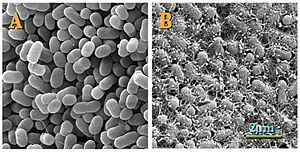E. coli O157:H7
| Escherichia coli O157:H7 | |
|---|---|
 |
|
| Topographical images of colonies of E. coli O157:H7 strains (A) 43895OW (curli non-producing) and (B) 43895OR (curli producing) grown on agar for 48 h at 28°C. | |
| Classification and external resources | |
| Specialty | infectious disease |
| ICD-10 | A04.3 |
| ICD-9-CM | 008.04 |
Escherichia coli O157:H7 is a serotype of the bacterial species Escherichia coli and is one of the Shiga toxin–producing types of E. coli. It is a cause of disease, typically foodborne illness of the "colonic escherichiosis" type, through consumption of contaminated and raw food, including raw milk. Infection with this type of pathogenic bacteria may lead to hemorrhagic diarrhea, and to kidney failure; these have been reported to cause the deaths of children younger than five years of age, of elderly patients, and of patients whose immunologies are otherwise compromised.
Transmission is via the fecal–oral route, and most illness has been through distribution of contaminated raw leaf green vegetables, undercooked meat and raw milk.
E. coli O157:H7 infection often causes severe, acute hemorrhagic diarrhea (although nonhemorrhagic diarrhea is also possible) and abdominal cramps. Usually little or no fever is present, and the illness resolves in five to 10 days. It can also be asymptomatic.
In some people, particularly children under five years of age, persons whose immunologies are otherwise compromised, and the elderly, the infection can cause hemolytic uremic syndrome (HUS), in which the red blood cells are destroyed and the kidneys fail. About 2–7% of infections lead to this complication. In the United States, HUS is the principal cause of acute kidney failure in children, and most cases of HUS are caused by E. coli O157:H7.
Strains of E. coli that express Shiga and Shiga-like toxins gained this ability due to infection with a prophage containing the structural coding for the toxin, and nonproducing strains may become infected and produce shiga-like toxins after incubation with shiga toxin positive strains. The prophage responsible seems to have infected the strain's ancestors fairly recently, as viral particles have been observed to replicate in the host if it is stressed in some way (e.g. antibiotics).
...
Wikipedia
